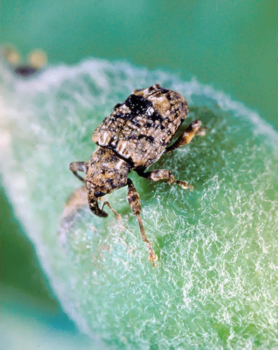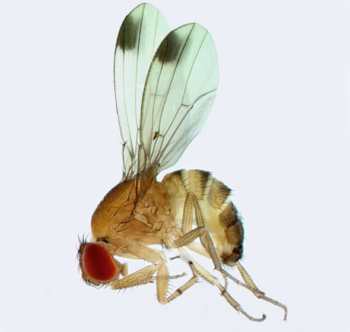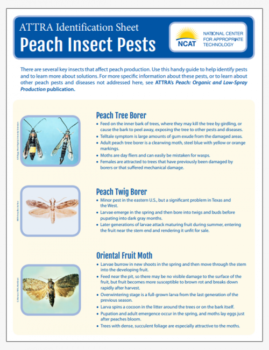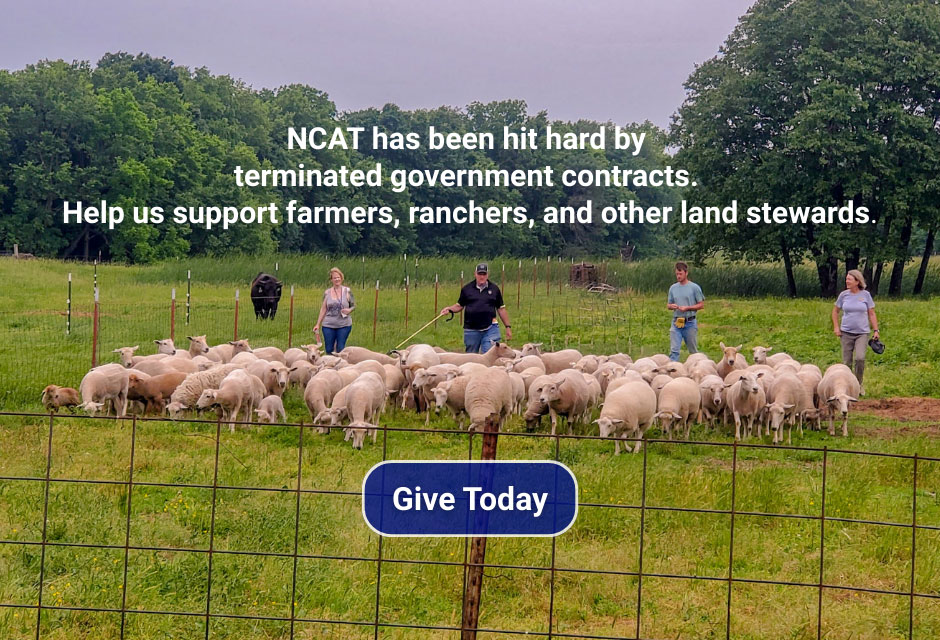ATTRA Identification Sheet: Peach Insect Pests
By Guy K. Ames, NCAT Agriculture Specialist
There are several key insects that affect peach production. Use this handy guide to help identify pests and to learn more about solutions. For more specific information about these diseases, or to learn about peach diseases not addressed here, see ATTRA’s Peach: Organic and Low-Spray Production publication.
Insects

Peachtree borer (female L.). Photo: A.R. Biggs, West Virginia University Extension, bugwood.org
Peach Tree Borer
Feed on the inner bark of trees, where they may kill the tree by girdling, or cause the bark to peel away, exposing the tree to other pests and diseases.
Telltale symptom is large amounts of gum exude from the damaged areas.
Adult peach tree borer is a clearwing moth, steel blue with yellow or orange markings.
Moths are day fliers and can easily be mistaken for wasps.
Females are attracted to trees that have previously been damaged by borers or that suffered mechanical.

Peach twig borer. Photo: INRA-Versailles Archive
Peach Twig Borer
Minor pest in the eastern U.S., but a significant problem in Texas and the West.
Larvae emerge in the spring and then bore into twigs and buds before pupating into dark gray months.
Later generations of larvae attack maturing fruit during summer, entering the fruit near the stem end and rendering it unfit for sale.

Oriental fruit moth. Photo: G. Morvan, Bugwood.org
Oriental Fruit Moth
Larvae burrow in new shoots in the spring and then move through the stem into the developing fruit.
Feed near the pit, so there may be no visible damage to the surface of the fruit, but fruit becomes more susceptible to brown rot and breaks down rapidly after harvest.
Overwintering stage is a full-grown larva from the last generation of the previous season.
Larva spins a cocoon in the litter around the trees or on the bark itself.
Pupation and adult emergence occur in the spring, and moths lay eggs just after peaches bloom.
Trees with dense, succulent foliage are especially attractive to the moths.

Plum curculio adult. Photo: Clemson University
Plum Curculio
Main insect of peaches east of the Rocky Mountains.
Moves into orchards from adjacent woodlots, fence rows, or hedges during bloom.
Damages fruit in three ways: 1) by direct feeding; 2) by laying eggs which become larvae and tunnel in the fruit; and 3) by spreading brown rot.
Impact can be severe—damage to more than 90% of fruit is not uncommon in unsprayed orchards.
Telltale sign of this insect is crescent-shaped oviposition (egg laying) marks.

Spotted wing drosophila. Photo: G. Arakelian, Oregon Dept. of Agriculture
Spotted Wing Drosophila
A member of the vinegar fly family, the SWD is related to the tiny fruit flies that are commonly seen in U.S. households around damaged, cut, or over-ripe fruit, but the SWD attacks undamaged, ripening fruit in the field.
The fly is gnat-size, with red eyes and a light light-brown body. The males have visible spots on the tips of their wings.
The female deposits her eggs in fruit (host range includes just about any thin-skinned fruit, including peaches, blueberries, grapes, plums, tomatoes, etc.).
Eggs hatch shortly thereafter, and the larvae tunnel and feed around the egg-laying site, causing noticeable depressions in the fruit. Often at this point, opportunistic bacteria and fungi invade the site and cause additional damage.
Can have 10 or more generations a year, and each female can lay 300 or more eggs.
Key Low-Spray and Organic Solutions
Peach Tree Borer
Pheromones for monitoring and for mating disruption are effective but, in order for the pheromones to work properly, the orchard needs to be at least three acres, and some say greater than five acres, in size.
Interior white latex paint, painted or sprayed on the base of the trunks, provides a physical barrier, inhibiting newly hatched larvae from entering the trunk. The paint also fills cracks in the bark, the preferred site for oviposition and larval feeding. Note that USDA Organic Regulations prohibit the use of any paint that contains synthetic materials in organic production.
Growers can use a knife or flexible wire to probe larvae out of the trunk and then kill them. The soil should first be removed from around the base of the tree to a depth of three inches, since larval damage also occurs under the soil line. This method is feasible for small plots but probably not practical in a commercial orchard.
The bacterium Bacillus thuringiensis (Bt) can be used to control the larvae before they have entered the trunk. Because Bt does not have a long residual effect, the trunk should be sprayed weekly during the peak period of moth flight, late July through August. A biological control, the commercially available insect-parasitic nematode Steinernema carpocapsae, has also been used successfully to manage peach tree borers when applied as a lower-trunk drench in warm spring or fall weather.
Peach Twig Borer
Treatment after borers have entered the tree is much less effective than treatment during the dormant or bloom periods. Peach twig borers are usually not a problem in orchards that are sprayed each year at the delayed dormant period with lime sulfur or with a 3% oil emulsion. Two to three Bt sprays at bloom also appear to be effective against this pest.
The peach twig borer has many natural enemies and parasites, including the parasitic wasps Paralitomastix varicornis, Macrocentrus ancylivorus, Euderus cushmani, Hyperteles lividus, Erynnia species and Bracon gelechiae, as well as the grain mite Pyemotes ventricosus. The California gray ant, Formica arrata, can be beneficial when it preys on peach twig borer, but it unfortunately also protects aphids and scales. Other predators of the peach twig borer include lacewings, ladybugs, and minute pirate bugs. These insects can be attracted to the orchard by habitat plantings, cover crops, and hedgerows.
Mating disruption can also be effective if properly implemented.
Oriental Fruit Moth
Pheromone-based mating disruption systems for Oriental fruit moth are proven, effective, and easy to use. One product, the Isomate-M™ pheromone dispenser, has proven as effective as chemical control in California tests. Note that there are some restrictions to pheromone use in organic production.
Degree-day models or charts can help in timing pesticide application or placing mating disruption lures to coincide with the emergence of the pest. Also choose the right peach varieties. Early-maturing types discourage damage because the peaches are picked before the insects attack the fruit.
Don’t overlook cultural controls. Remove infested fruit and stem tips to further reduce populations. Good orchard sanitation—removing leaf litter and dropped or culled fruit where larvae overwinter—will further reduce attacks. Dormant larvae can be destroyed by cultivating to a depth of two to four inches, one to three weeks before the peaches bloom. Annual pruning to control overly vigorous growth on the trees makes them less attractive to the moths.
Parasitic braconid wasps can be used as part of an IPM strategy. Growers have had success with five releases of adult wasps four days apart, beginning in May and using about 500 adults per acre. To control the moth effectively, some growers supplement a parasitic insect program with a single spray of an appropriate insecticide shortly before harvest.
Plum Curculio
Fruits that are infested with curculio larvae normally drop from the tree before the larvae complete their feeding. Therefore, prompt gathering and disposal of these fruit drops—before the larvae leave them to enter the soil—reduces the number of first-generation adults.
Disking or otherwise cultivating during the pupal period is a mechanical control method. In its pupal form, the plum curculio is very fragile. If the pupal cell is disturbed, it fails to transform into an adult. Pupation usually occurs within the upper two inches of soil. The most desirable time to begin cultivation for destruction of pupae is about three weeks after the infested fruits start to drop from the tree. Cultivation should be continued at weekly intervals for a period of several weeks. Cultivation before the curculios pupate is of little value.
Surround™ WP Crop Protectant, derived from processed kaolin clay, is an OMRI-approved organic pest-control product shown to be effective for control of plum curculio. Surround is unique in that it provides pest control through particle-film technology rather than toxic chemistry. Peach growers should discontinue seasonal sprays of Surround when the fruit is three centimeters (slightly more than one inch) or less in diameter.
PyGanic™ is an OMRI-approved, pyrethrumbased (from the pyrethrum daisy), quick-knockdown, short-residual, broad-spectrum insecticide. It seems to be the organic pesticide of choice for plum curculio control. One of PyGanic’s beneficial qualities—the short residual life (i.e., it biodegrades quickly, in about 12 hours)—is also one of its weaknesses because you have to spray often.
The synthetic insecticide Imidan™ (phosmet) has been the mainstay of integrated pest management of plum curculio because of its relatively low mammalian toxicity, its two-week persistence (meaning usually only two sprays for plum curculio control—at petal fall and two weeks later), and its low impact on beneficial insects.
Spotted Wing Drosophila
There is not yet an established control protocol. The least-toxic, effective pesticide appears to be spinosad, a biological insecticide which is OMRI approved. It should be cautioned, however, that the spinosad-containing GF-120™ bait that is used for cherry fruit fly does not seem to be attractive to drosophila.
Oregon State University describes how to make a simple and inexpensive trap for monitoring here.
ATTRA Identification Sheet: Peach Insect Pests
By Guy K. Ames, NCAT Agriculture Specialist
Published November 2014
©NCAT
IP478, slot 490
This publication is produced by the National Center for Appropriate Technology through the ATTRA Sustainable Agriculture program, under a cooperative agreement with USDA Rural Development. ATTRA.NCAT.ORG.


